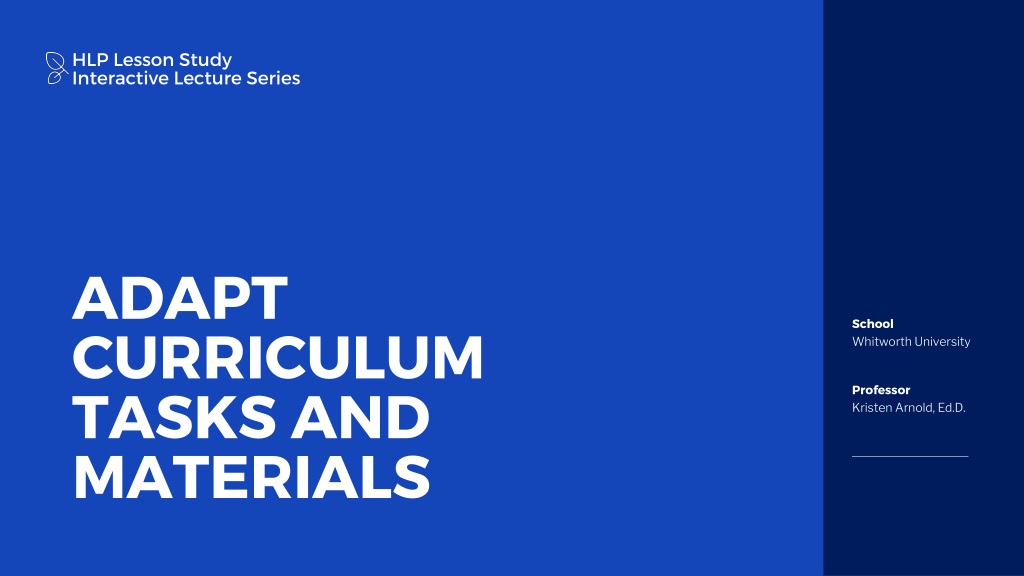

Replay
0 likes | 12 Vues
Understand the importance of adapting curriculum tasks and materials to enhance student access and learning experiences in inclusive classrooms. Explore ways to differentiate instruction and make strategic decisions to meet individual student needs. The session covers content enhancements, utilizing the Equalizer tool, and assessing student needs to facilitate instructional goals effectively.

E N D
HLP Lesson Study Interactive Lecture Series ADAPT CURRICULUM TASKS AND MATERIALS School Whitworth University Professor Kristen Arnold, Ed.D.
Welcome to today's class! Study Series HLP Lesson Today's Agenda 01 Research Synthesis Summary & Review Activity HLP13 Video Review 02 Differentiate the Content, Process, or Product 03 The Equalizer Exercise 04 Classroom Connection: Extreme Assessment Makeover 05 To participate today, you will need this textbook and your Reading Response Journal. 02
Study Series HLP Lesson Learning Objectives Describe different ways to adapt curriculum tasks and materials so that students are better able to access learning experiences and content within inclusive classrooms. Curricular Adaptations Understand how content enhancements can provide scaffolding for students who need additional support completing learning tasks. Content Enhancements Be able to effectively differentiate instruction by adapting curricular content, process, or product using the Equalizer tool as a guide. Differentiation Methods 03
Study Series HLP Lesson Today's topic HLP #13: Adapt Curriculum Tasks and Materials Adapt curriculum tasks and materials for specific learning goals. 04
HLP13 Study Series HLP Lesson Teachers assess individual student needs and adapt curriculum materials and tasks so that students can meet instructional goals. Teachers select materials and tasks based on student needs; use relevant technology; and make modifications by highlighting relevant information, changing task directions, and decreasing amounts of material. Teachers make strategic decisions about content coverage (i.e., essential curriculum elements); meaningfulness of tasks to meet stated goals; and criteria for student success (McLeskey et al., 2017, p. 74). Let's Discuss and Analyze Together Pause, Reflect, and Connect = 20 minutes • Pause Pause to re-read this HLP once more, reviewing your notes and highlights on pp. 170-180 in your HLP Inclusive text. • Reflect Reflect on how implementing HLP13 can create a bridge between students and the content. How does this relate to equity in the inclusive classroom? • Connect Connect the concept of differentiated instruction (DI) to your practicum classroom. Are learning processes and products adjusted to meet student needs? If so, what does this look like? If not, what are areas that you might explore to differentiate instruction? 05
Study Series HLP Lesson Adapting Curriculum Well-selected and well-sequenced learning goals are meaningless if students cannot access them. When designing instructional tasks and materials, teachers must realize their decisions can either promote or inhibit student access; they must understand that barriers to learning may arise when individual students interact with the materials and tasks (Alber-Morgan et al., 2019, p. 170). 06
Study Series HLP Lesson HLP13 Video Review = 25 minutes In your Reading Response Journal, respond to the prompts in the graphic organizer under HLP13 as you watch the video. Pause the video to record your thoughts and refer to your text as needed. 07
Differentiated Instruction: Adjusting the Content, Process, and Product Study Series HLP Lesson We have previously reviewed the definition of differentiated instruction, comparing differentiated classrooms to traditional. We have also studied the tenets of Universal Design for Learning (UDL), blended learning approaches, classroom management, and the importance of creating multiple access points for students to engage in content and represent what they know. Now it is time to dive into HOW we differentiate. 08
The Equalizer Exercise Study Series HLP Lesson • Together, we will take an introductory look at the Equalizer tool using the link below (Tomlinson, 2011). • Then, we will examine two common formative assessment types used in our local schools: an elementary and secondary example. • After evaluating each assessment, we will use Carol Ann Tomlinson's Equalizer tool to make curricular adjustments based on the needs of two case-study students. 09 https://pdo.ascd.org/LMSCourses/PD11OC138M/media/DI-Instruction_M5_Reading_Equalizer.pdf
Classroom Connection Study Series HLP Lesson Formative Assessment Fixer-Upper = asynchronous homework Please have a copy of the assignment description ready to review. 10
Study Series HLP Lesson Recap of today's class Connection to Practice 1 Connection to Practice 3 In what ways does adapting curriculum tasks and materials for specific learning goals help all students learn more effectively? What are best practices for grading students with disabilities? Connection to Practice 2 Connection to Practice 4 How can you build on previous HLPs (use of assessment data and collaboration) to adapt curriculum tasks and materials? How can I practice adapting curriculum tasks and materials at my school site NOW? 11
References Causton-Theoharis, J., & Tracy-Bronson, C. P. (2015). The educator's handbook for inclusive school practices. Paul H. Brookes. Study Series HLP Lesson Konrad, M., Hessler, T., Alber-Morgan, S. R., Davenport, C. A., & Helton, M. R. (2019). Systematically design instruction toward a specific learning goal. In J. McLeskey, L. Maheady, B. Billingsley, M. T. Brownell, & T. J. Lewis (eds.), High-leverage practices for inclusive classrooms. Council for Exceptional Children & CEEDAR. McLeskey, J., Barringer, M-D., Billingsley, B., Brownell, M., Jackson, D., Kennedy, M., Lewis, T., Maheady, L., Rodriguez, J., Scheeler, M. C., Winn, J., & Ziegler, D. (2017, January). High-leverage practices in special education. Council for Exceptional Children & CEEDAR Center. Tomlinson, C. A. (2017). How to differentiate instruction in academically diverse classrooms (3rd ed.). Association for Supervision and Curriculum. 12